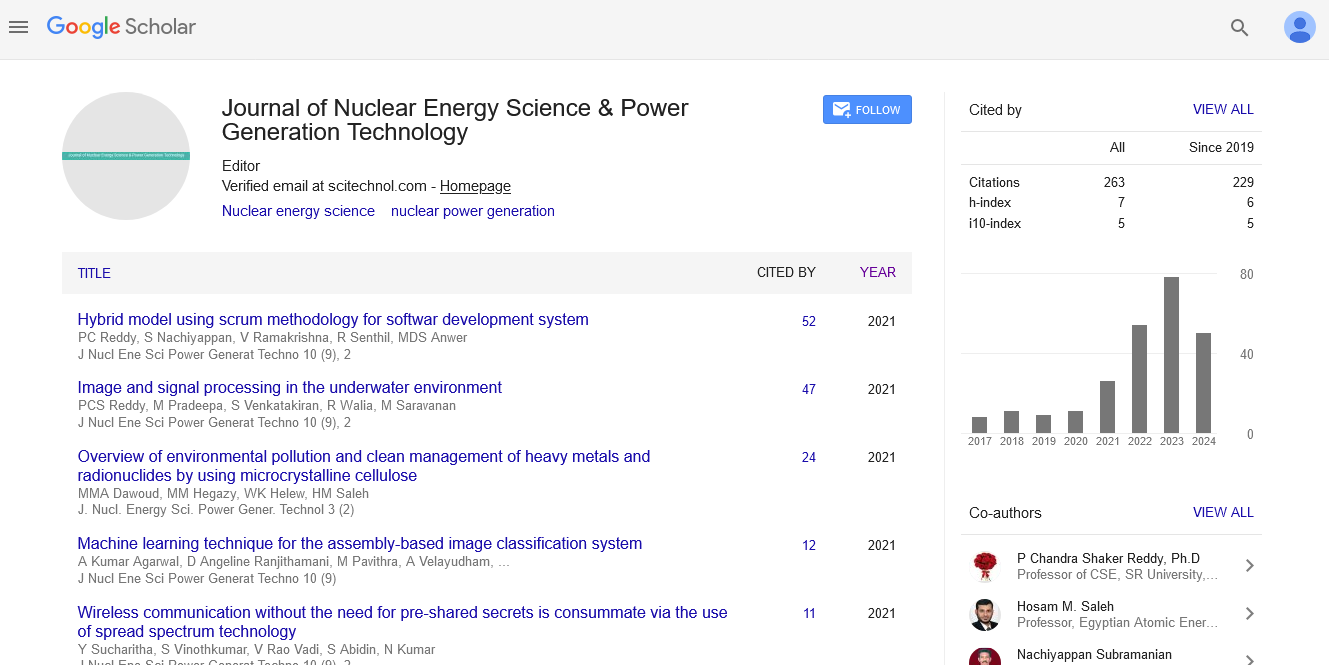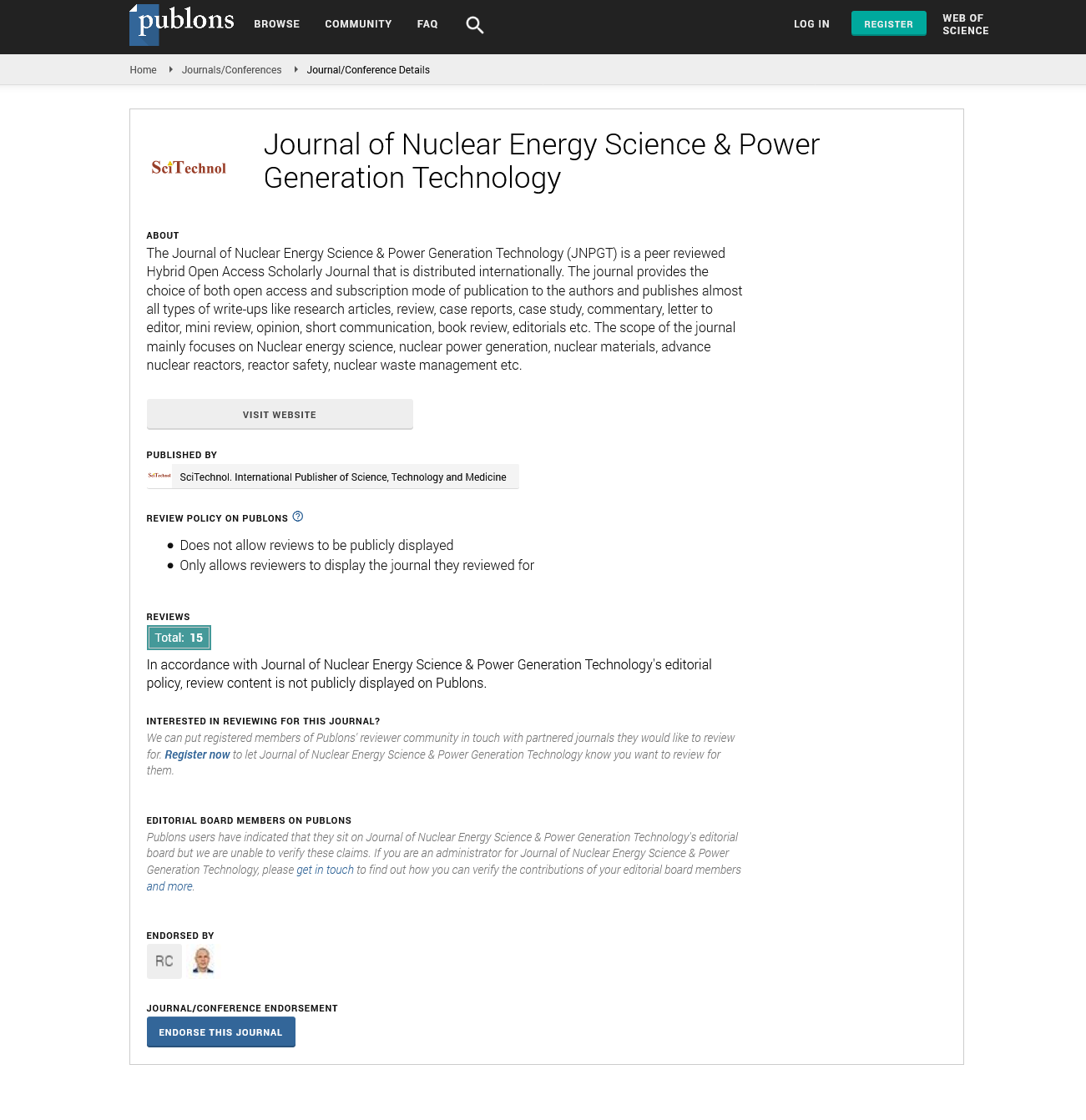Commentary, J Nucl Ene Sci Power Generat Technol Vol: 13 Issue: 6
A Study on the Innovation and Sustainability of Gen IV Reactor Designs
Marcus Helms*
1Department of Advanced Nuclear Systems Laboratory, Seoul National University, Seoul, South Korea
*Corresponding Author: Marcus Helms,
Department of Advanced Nuclear
Systems Laboratory, Seoul National University, Seoul, South Korea
E-mail: marcus_helms32@gmail.com
Received date: 21 October, 2024, Manuscript No. JNPGT-24-154871;
Editor assigned date: 23 October, 2024, PreQC No. JNPGT-24-154871 (PQ);
Reviewed date: 06 November, 2024, QC No. JNPGT-24-154871;
Revised date: 13 November, 2024, Manuscript No. JNPGT-24-154871 (R);
Published date: 21 November, 2024, DOI: 10.4172/2325-9809.1000425.
Citation: Helms M (2024) A Study on the Innovation and Sustainability of Gen IV Reactor Designs. J Nucl Ene Sci Power Generat Technol 13:6.
Description
The persistent global need for sustainable and low-carbon energy solutions has placed nuclear energy at the front of modern energy debates. Among the most capable advancements in nuclear technology are Generation IV (Gen IV) reactor designs. These innovative systems potential improved efficiency, enhanced safety and better resource utilization, making them essential in determining the future of nuclear energy. The history of nuclear reactors spans four generations. Generation I reactors marked the initial incursion into nuclear power, focusing on proof-of-concept designs. Subsequent Generation II and III designs improved operational efficiency and safety while managing cost and scalability challenges. Generation IV reactors, however, aim to redefine the example by incorporating cutting-edge technologies to achieve unprecedented levels of performance. Gen IV reactors prioritize sustainability, efficiency and safety while managing the limitations of earlier designs, such as long-lived radioactive waste and resource constraints. The Gen IV International Forum (GIF), established in 2000, has identified six reactor technologies: Sodium- Cooled Fast Reactors (SFRs), Gas-Cooled Fast Reactors (GFRs), Lead-Cooled Fast Reactors (LFRs), Very High Temperature Reactors (VHTRs), Molten Salt Reactors (MSRs) and Supercritical-Water-Cooled Reactors (SCWRs). Safety is a basis of Gen IV reactors. These designs integrate passive safety systems that operate without human intervention or external power sources. For instance, SFRs utilize liquid sodium as a coolant, which has a high heat capacity and low pressure, minimizing the risk of catastrophic failures. Similarly, MSRs depend on molten salt as both fuel and coolant, which inherently limits radioactive release in case of an accident. Gen IV reactors maximize fuel efficiency by enabling the use of alternative fuels like thorium or depleted uranium, significantly extending the life of existing nuclear resources. Fast reactors, such as GFRs and LFRs, are particularly adept at recycling spent fuel, reducing the burden of radioactive waste and lowering long-term storage requirements.
Operating at higher temperatures than their prototypes, Gen IV reactors achieve greater thermal efficiency, making them more competitive with fossil fuels. VHTRs, for example, can generate heat at temperatures exceeding 1000°C, which not only improves power generation efficiency but also opens opportunities for industrial applications, such as hydrogen production. Despite this Gen IV reactors face several challenges. The development and deployment of these reactors require substantial upfront investment in research, infrastructure and regulatory compliance. Investments in public education, stringent safety protocols and transparent communication about the benefits and risks of Gen IV technology are important for gaining societal acceptance.
Conclusion
As the world contends with the dual challenges of climate change and energy security, Generation IV nuclear reactors provide a favorable solution and the limitations of earlier designs and incorporating innovative Gen IV reactors represent the potential of nuclear technology to initiate a sustainable energy future. While challenges remain, the commitment to advancing these technologies could sign a new era of efficient, safe and environmentally responsible nuclear energy. Gen IV reactors have the potential to play a essential role in combating climate change by providing a reliable, low-carbon energy source. Unlike intermittent renewable energy sources such as wind and solar, nuclear reactors can deliver consistent power output, ensuring energy security. Moreover, the integration of Gen IV technology with renewable systems can help establish a balanced and adaptable energy mix.
 Spanish
Spanish  Chinese
Chinese  Russian
Russian  German
German  French
French  Japanese
Japanese  Portuguese
Portuguese  Hindi
Hindi 

